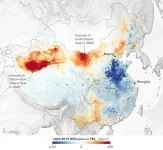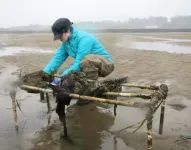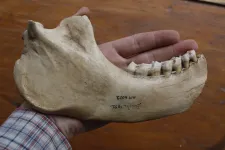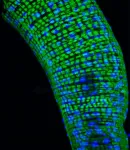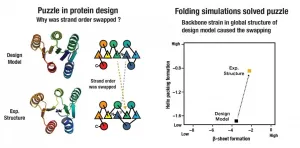(Press-News.org) Early in the pandemic, it was expected that satellite imagery around the world would show cleaner air as a result of COVID-19 lockdowns. But not all pollutants were taken out of circulation. For tiny airborne-particle pollution, known as PM 2.5, researchers using NASA data found that variability from meteorology obscured the lockdown signals when observed from space.
"Intuitively you would think if there is a major lockdown situation, that we would see dramatic changes, but we didn't," said Melanie Hammer, a visiting research associate at Washington University in St. Louis who led the study. "It was kind of a surprise that the effects on PM 2.5 were modest."
PM 2.5 describes the mass of nose-level particles, often produced anthropogenically, that are smaller than 2.5 micrometers, or roughly 30 times smaller than the width of a human hair. PM 2.5 is small enough to linger in the atmosphere, and, when inhaled, is associated with increased risk of heart attack, cancer and a host of other implications for human health.
By combining NASA spacecraft data with ground-based monitoring and an innovative computer modeling system, the scientists mapped PM 2.5 levels across China, Europe and North America during the early months of the pandemic. The researchers found seasonal differences in PM 2.5 between recent years were driven primarily by the natural variability of the meteorology, not by pandemic lockdowns.
Published June 23 in the journal Science Advances, the new research integrates data from NASA's Terra and Aqua satellites, as well as meteorological modeling input from the NASA Global Modeling and Assimilation Office.
The meteorological effects analyzed in the study include changes in the sources of mineral dust, the way pollutants react to sunlight in the atmosphere, mixing and heat transfer, as well as the removal of pollutants from the atmosphere by precipitation.
PM 2.5 is among the most complicated pollutants to study because its particle size, composition and toxicity vary greatly depending on its source and environmental conditions.
A gas pollutant known as nitrogen dioxide, or NO2, did see dramatic declines during the lockdowns. A major byproduct of fuel burning by trucks, cars and other vehicles, the decline of nitrogen dioxide was visible from space and from the ground. Images of clear, blue skies where heavy smog had been the norm flooded popular news and social media, suggesting COVID-19 has drastically decreased all pollution in general.
When nitrogen dioxide is emitted, it can also interact with other chemicals in the atmosphere and form PM 2.5. However, the two pollutants do not have a linear relationship. Half as much nitrogen dioxide in the atmosphere does not necessarily lead to half as much PM 2.5 produced by nitrogen dioxide.
Because PM 2.5 often comes from the same sources as NO2, the researchers also began to question whether the lockdowns resulted in a decline of PM 2.5.
Early pandemic studies of PM 2.5 changes analyzed data from ground monitoring sites, which test the surrounding air. But because those ground sites are few and far between, their data alone are unable to piece together the bigger picture of PM 2.5 concentrations in the air, Hammer said.
"We were most interested in looking at changes in PM 2.5 because PM 2.5 is the leading environmental risk factor for premature mortality globally," Hammer said. "We decided to look again, using a more complete picture from satellite images."
The study was co-led by Randall Martin at Washington University in St. Louis, who pioneered research integrating modeling and remote sensing to study atmospheric pollutants such as PM 2.5.
"Many countries in the world have no operational PM 2.5 monitoring at all," Martin said. "These tools enable insight into ground level PM 2.5 at the global or regional scale."
To ensure a comprehensive analysis, the team focused on regions with extensive ground monitoring systems in place and compared monthly estimates of PM 2.5 from January to April in 2018, 2019 and 2020.
When the researchers compared PM 2.5 levels over the three years during the months that coincided with each region's lockdown phases, there weren't many clear signals over North America or Europe. The most significant lockdown-related differences were detected in China.
"We found the most clearly detectable signal was a significant reduction over the North China Plain, where the strictest lockdowns were concentrated," Hammer said.
To figure out whether the lockdown was responsible for that signal, and several smaller ones dotted around the areas surveyed, the team ran different "sensitivity simulations" using GEOS-Chem, a chemical transport model to which Martin's team helps lead.
They simulated a scenario where anthropogenic emissions of nitrogen dioxide were held constant and meteorological variability was solely responsible for year over year differences in PM 2.5 during the key lockdown months. They also ran simulations in which they reduced transportation-related emissions and other anthropogenic sources of nitrogen dioxide, mirroring lockdown, when fewer people were driving and fewer industrial sites were operational.
They found the simulation where both meteorology and transportation effects were included most closely mirrored the real-world situation.
"Tackling PM 2.5 is a very complex issue, and you have to take into account its multiple sources, not just the fact that fewer people are on the road," Hammer said. "Just decreasing transportation emissions would not be enough to account for the complexity of the problem."
Most satellites sample the atmosphere through vertical columns spanning the ground to the edge of space. Identifying the concentrations of airborne particles near the surface, where they affect air quality, cannot be determined from these satellites alone.
The satellite data used in this study, referred to as aerosol optical depth, were related to surface PM 2.5 concentrations using GEOS-Chem, which simulates the composition of the atmosphere, the reactions and relationships among its different components, and the way they move horizontally as well as vertically through the air.
The model is a sophisticated tool that helps paint a more complete picture of air quality, said Ralph A. Kahn, senior research scientist at NASA's Goddard Space Flight Center in Greenbelt, Maryland and adjunct professor at University of Maryland in College Park.
"The bigger story is actually the global characterization of air quality, especially in places where there aren't surface monitors," said Kahn, who was part of the study. "The satellites provide an important piece of it, the models provide an important piece of it, and the ground-based measurements make an important contribution as well."
Hammer suspects the change in PM 2.5 levels over the North China Plain was more apparent because of the region's higher pollution levels during "normal" times.
The new insights also highlight a relevant point that may not at first be intuitive: Average PM 2.5 levels have been dropping steadily in North America and Europe. Pollution concentrations that are already low are more difficult to change, Hammer said.
INFORMATION:
By Brandie Jefferson
Washington University in St. Louis
Media Contact: Roberto Molar Candanosa, NASA's Earth Science News Team
Tooth loss is often accepted as a natural part of aging, but what if there was a way to better identify those most susceptible without the need for a dental exam?
New research led by investigators at Harvard School of Dental Medicine suggests that machine learning tools can help identify those at greatest risk for tooth loss and refer them for further dental assessment in an effort to ensure early interventions to avert or delay the condition.
The study, published June 18 in PLOS ONE, compared five algorithms using a different combination of variables to screen for risk. The results showed those that factored medical characteristics and socioeconomic variables, such as race, education, arthritis, and diabetes, outperformed algorithms that relied on dental clinical indicators alone.
"Our ...
A new resource developed at the Garvan Institute of Medical Research and The Kinghorn Cancer Centre for oncologists could help make targeted cancer therapies more accessible for Australian patients.
The TOPOGRAPH (Therapy-Oriented Precision Oncology Guidelines for Recommending Anti-cancer Pharmaceuticals) database is an online tool that catalogues oncology research to streamline the process of recommending therapeutic treatments in precision cancer medicine.
Garvan Senior Research Officer Dr Frank Lin led the development of the platform reported this week in the journal npj Precision Oncology.
"TOPOGRAPH is uniquely useful in the Australian context because it combines ...
Wastewater treatment facilities clean the water that goes down our sinks and flushes our toilets, but they do not remove everything. A recent study by Portland State researchers detected low levels of pharmaceuticals and personal care product chemicals in oysters the team deployed at various distances from wastewater effluent pipes along the Oregon and Washington coast. Elise Granek, professor of environmental science and management at Portland State University, and Amy Ehrhart, a recent graduate of PSU's Earth, Environment, and Society doctoral program, conducted the study.
To explore how aquatic pollution varies based on proximity to wastewater facilities, Ehrhart and Granek placed one-week-old ...
Researchers at Harvard University and the Broad Institute of MIT and Harvard have created a first detailed atlas of a critical region of the developing mouse brain, applying multiple advanced genomic technologies to the part of the cerebral cortex that is responsible for processing sensation from the body. By measuring how gene activity and regulation change over time, researchers now have a better understanding of how the cerebral cortex is built, as well as a brand new set of tools to explore how the cortex is affected in neurodevelopmental disease. The study is published in the journal Nature.
"We have had a long-standing interest in understanding the development of the mammalian cerebral cortex, as it is ...
UNIVERSITY PARK, Pa. -- Using an unusually well-preserved subfossil jawbone, a team of researchers -- led by Penn State and with a multi-national team of collaborators including scientists from the Université d'Antananarivo in Madagascar -- has sequenced for the first time the nuclear genome of the koala lemur (Megaladapis edwardsi), one of the largest of the 17 or so giant lemur species that went extinct on the island of Madagascar between about 500 and 2,000 years ago. The findings reveal new information about this animal's position on the primate family tree and how it interacted with its environment, which could help in understanding the impacts of past lemur extinctions on Madagascar's ecosystems.
"More than 100 species of lemurs live on Madagascar today, ...
To better understand the role of bacteria in health and disease, National Institutes of Health researchers fed fruit flies antibiotics and monitored the lifetime activity of hundreds of genes that scientists have traditionally thought control aging. To their surprise, the antibiotics not only extended the lives of the flies but also dramatically changed the activity of many of these genes. Their results suggested that only about 30% of the genes traditionally associated with aging set an animal's internal clock while the rest reflect the body's response to bacteria.
"For ...
COLUMBUS, Ohio - When the summer sun blazes on a hot city street, our first reaction is to flee to a shady spot protected by a building or tree.
A new study is the first to calculate exactly how much these shaded areas help lower the temperature and reduce the "urban heat island" effect.
Researchers created an intricate 3D digital model of a section of Columbus and determined what effect the shade of the buildings and trees in the area had on land surface temperatures over the course of one hour on one summer day.
"We can use the information from our model to formulate guidelines for community greening and tree planting efforts, and even where to locate buildings to maximize shading on other buildings and roadways," said Jean-Michel Guldmann, co-author of the study and ...
A new tool to help conserve one of the UK's most threatened mammals has been released today, with the publication of the first high-quality reference genome for the European water vole. The genome was generated by scientists at the Wellcome Sanger Institute, in collaboration with animal conservation charity the Wildwood Trust, as part of the Darwin Tree of Life Project.
The genome, published today (24 June 2021) through Wellcome Open Research, is openly available as a reference for researchers seeking to assess water vole population genetics, better understand how the species has evolved and to manage reintroduction efforts.
The European water vole (Arvicola ...
A team from Japan and the United States has identified the design principles for creating large "ideal" proteins from scratch, paving the way for the design of proteins with new biochemical functions.
Their results appear June 24, 2021, in Nature Communications.
The team had previously developed principles to design small versions of what they call "ideal proteins," which are structures without internal energetic frustration.
Such proteins are typically designed with a molecular feature called beta strands, which serve a key structural role for the molecules. In ...
Our planet's strongest ocean current, which circulates around Antarctica, plays a major role in determining the transport of heat, salt and nutrients in the ocean. An international research team led by the Alfred Wegener Institute has now evaluated sediment samples from the Drake Passage. Their findings: during the last interglacial period, the water flowed more rapidly than it does today. This could be a blueprint for the future and have global consequences. For example, the Southern Ocean's capacity to absorb CO2 could decrease, which would in turn intensify climate change. The study has now been published in the journal Nature Communications.
The Antarctic Circumpolar Current (ACC) is the world's strongest ocean ...
